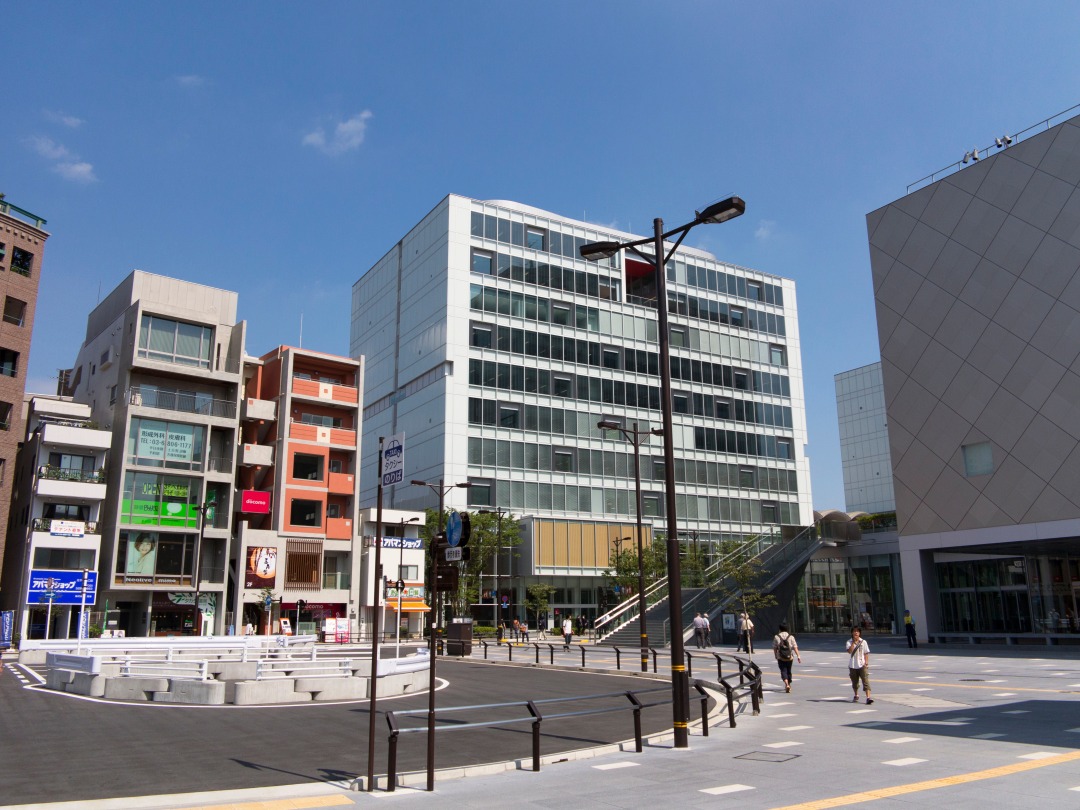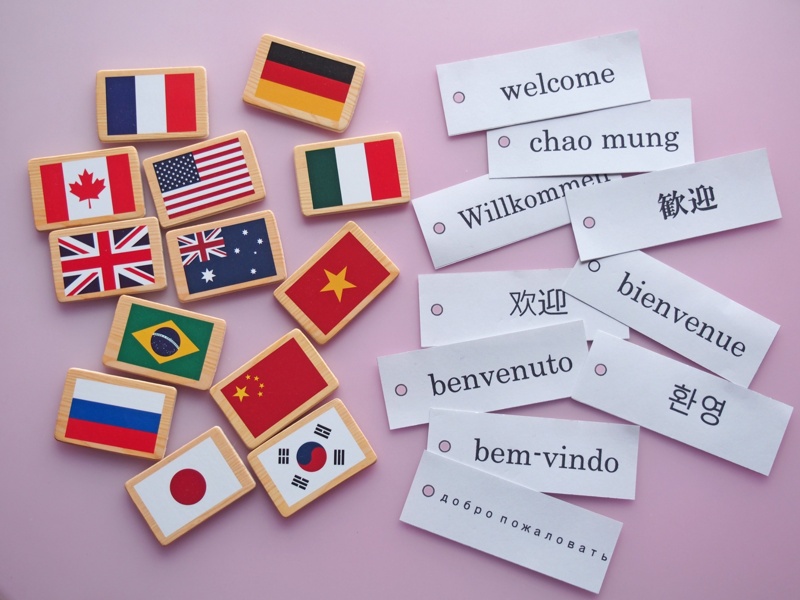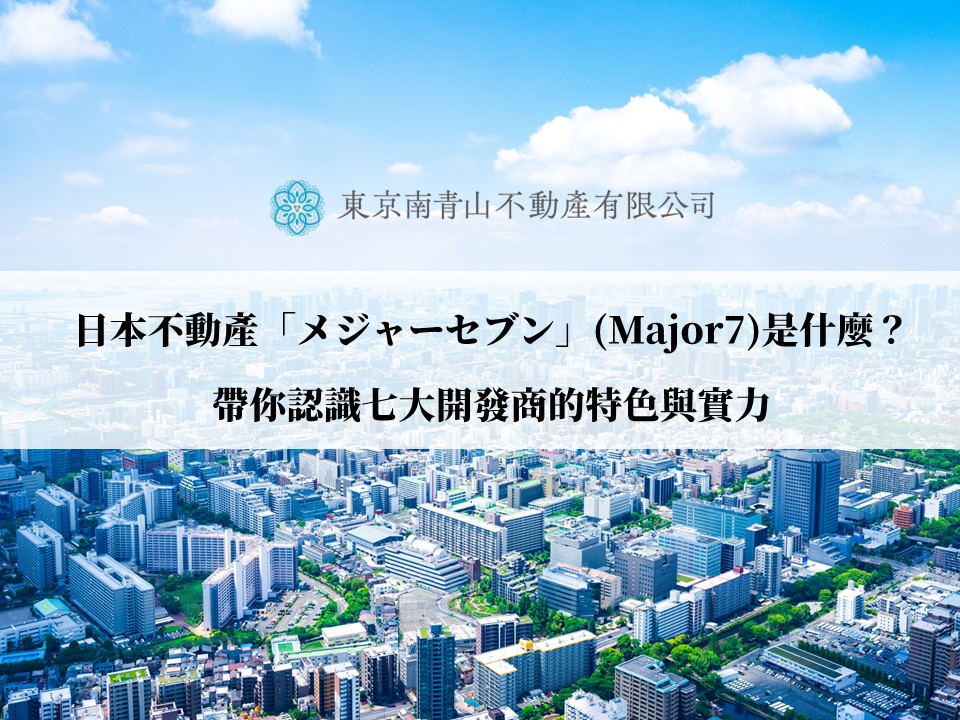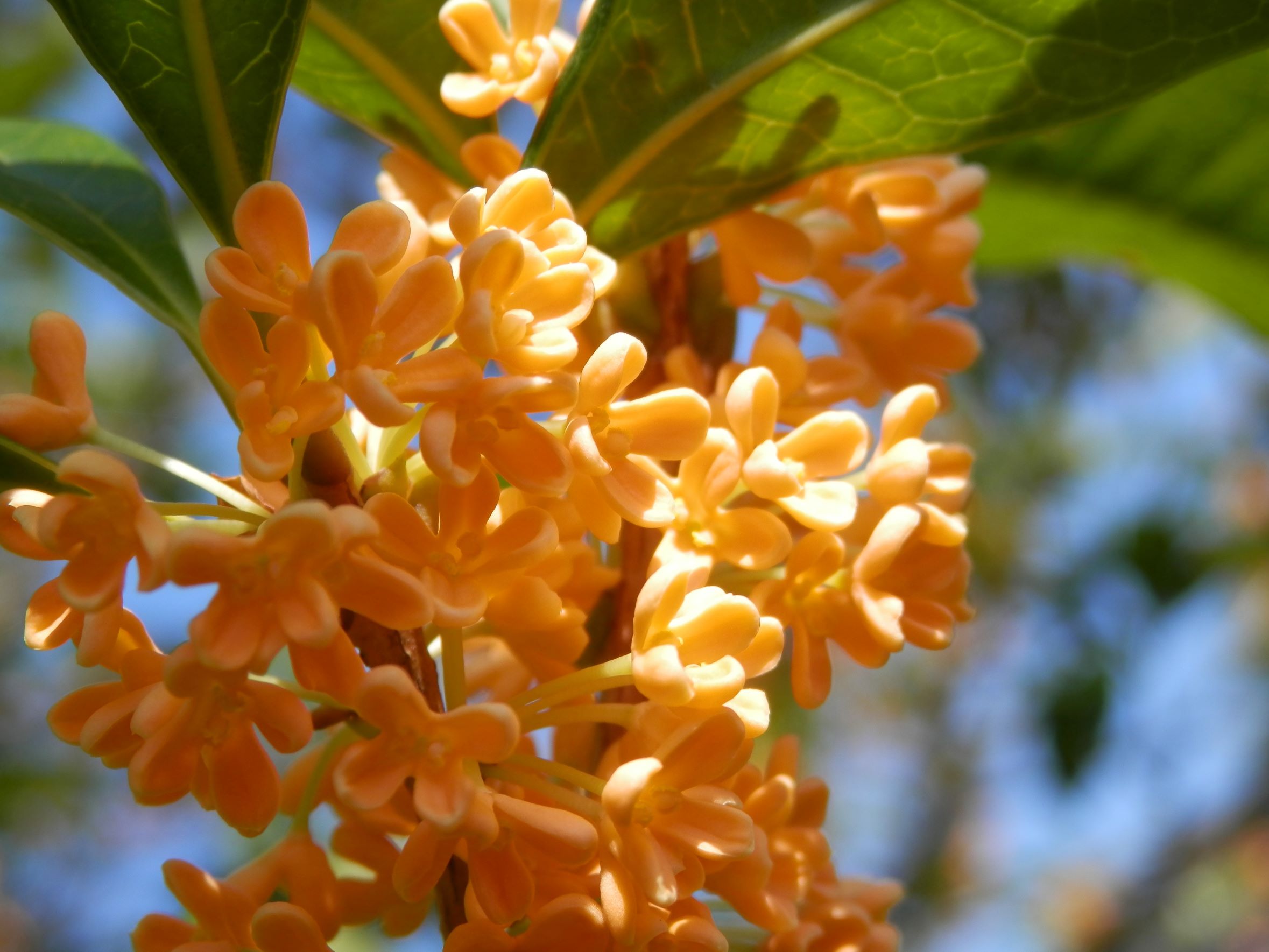Kita-Senju Station is located a little far away from the JR Yamanote Line and northeast of Tokyo's 23 wards. The area around Kita-Senju Station is unique in that it is surrounded by pioneering buildings, and at the same time, people can feel the atmosphere of the downtown.
In addition to the nostalgic shopping streets, the number of universities has increased recently. Moreover, high-rise condominiums have been built around the station, making it a city where not only people who live in this area but also students and families of all ages visit.
In this article, we will introduce basic information about Kita-Senju Station, its history, recommended spots, and so on.
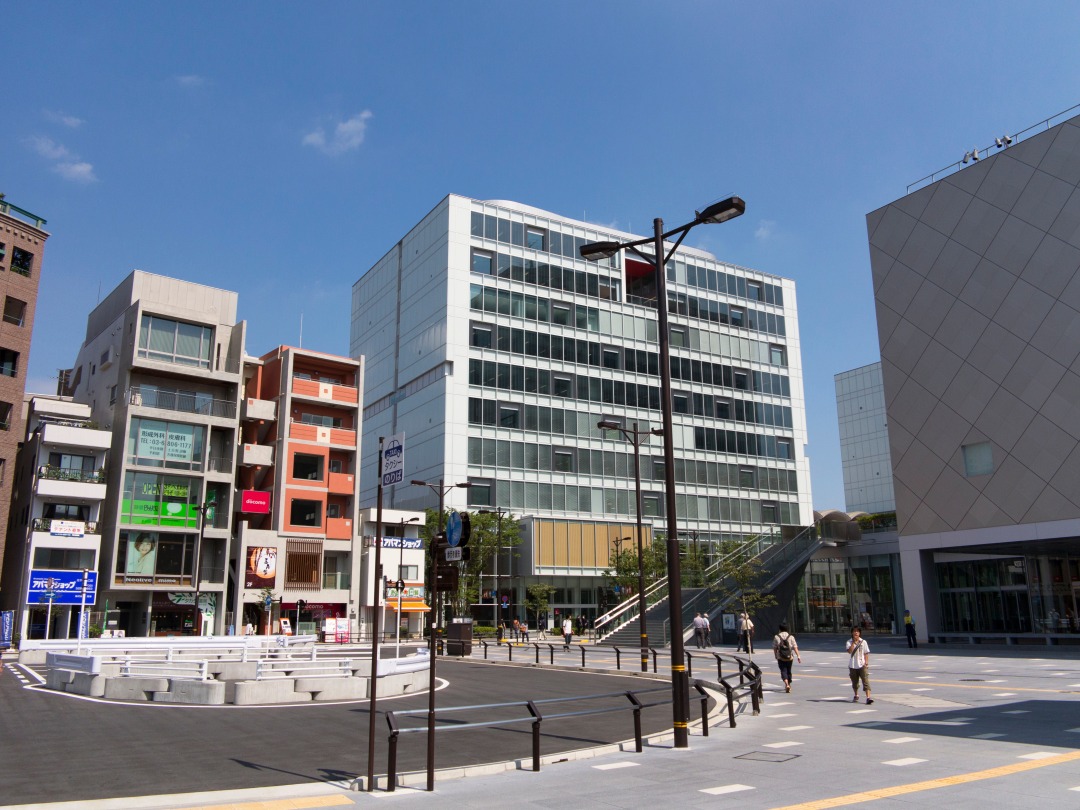
Why
Kita-Senju Station is in Adachi Ward, Tokyo. It is an area between the Sumida River and the Arakawa River. The name "Kita-Senju" comes from "Senju-juku," which developed as the first inn in this area during the Edo period. After the Meiji era, the name was changed to "Senju-juku Kitagumi" and "Kita-Senju". The station was named after that.
The area around Kita-Senju Station is one of the busiest areas in Adachi Ward, with many department stores and shopping streets. Kita-Senju Station is in the twenty-three wards and multiple train lines pass through here. Moreover, rents and prices are lower than in the city center, so it becomes popular for single-person and family households. Therefore, in recent years, it has been ranked No. 1 in the "Hidden Gem City" ranking for seven years. It is undoubtedly an area that full of potential.
In addition, according to the data on the number of passengers by station released by the Ministry of Land, Infrastructure, Transport and Tourism in 2022, the average number of passengers at Kita-Senju Station in 2021 was 337,132 per day, ranking the eighth highest station among Japan Railways. The number of passengers using Kita-Senju Station is higher than that of Akihabara Station (11th) and Ueno Station (14th). This means that the population of Naha City in Okinawa (which is about 310,000 people, February 2024) plus another 20,000 people stop by Kita-Senju Station in one day.
Source: Ministry of Land, Infrastructure, Transport and Tourism National Land Numerical Information Download Site "Number of Passengers by Station Data"
Source: Statistical Information Research "Statistics on the number of passengers at Kita-Senju Station (JR East Japan)"
Source: Naha City "Naha City Statistics"
Crowd levels in Kita-Senju Station per weekday is as follows.
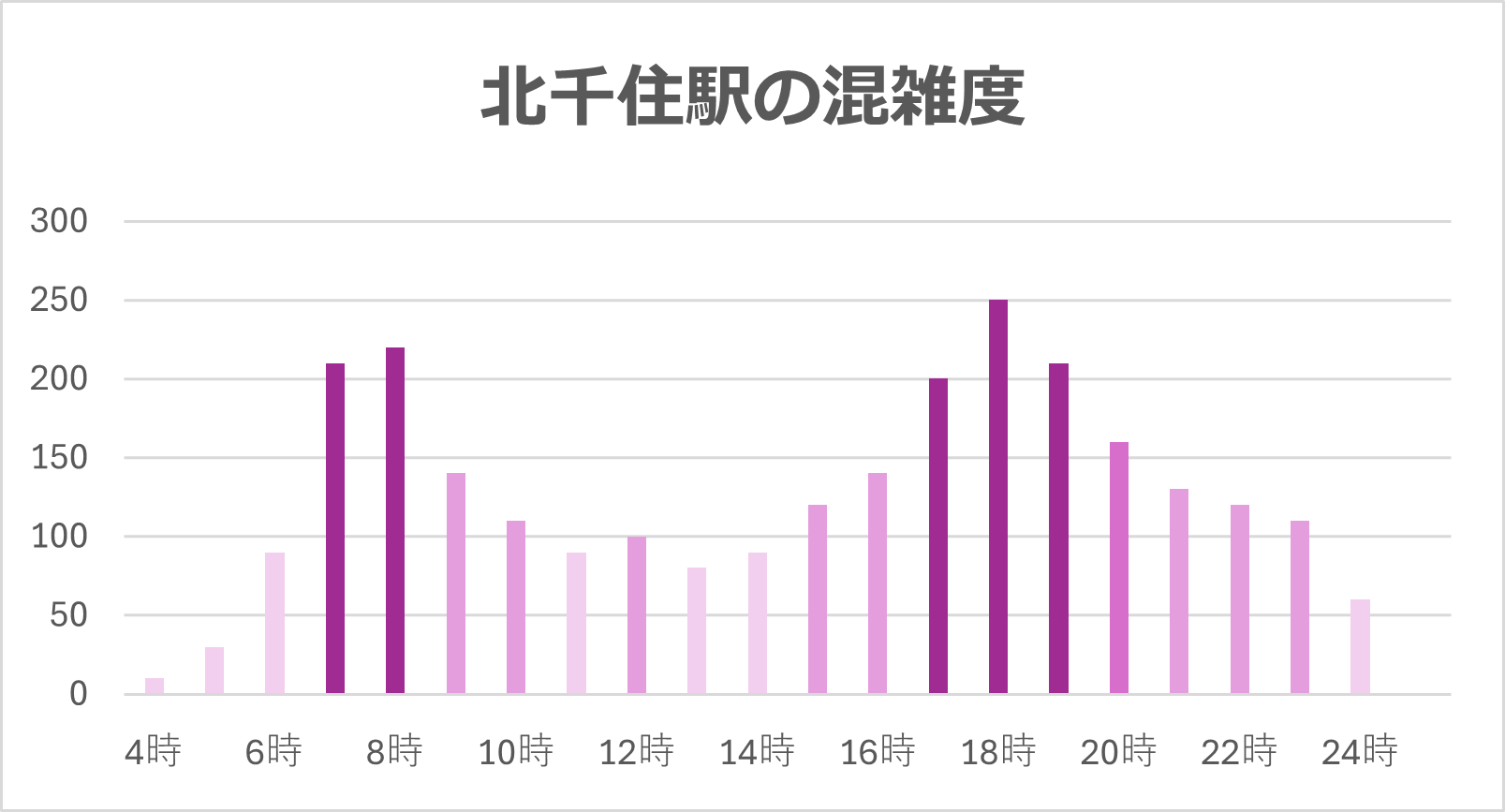
* Created independently by processing from JR East Japan's official website "Station Crowding Situation" and NAVITIME "crowd predictor."
* Classified into four crowd levels according to the numbers on the vertical axis. Very crowded (200~250), crowded (150~200), not very crowded (100~150), vacant (0~100)
Rush hours are between 7 o'clock to 8 o'clock. Since there are many people commuting to work and school from Kita-Senju, it is said that rush hours are earlier than Tokyo Station and Shinagawa Station.
Train Lines serve Kita-Senju
Kita-Senju Station is served by a total of six train lines, including the following.
JR East Japan
● Joban Line Rapid
● Ueno Tokyo Line
subway
● Tokyo Metro Hibiya Line
● Tokyo Metro Chiyoda Line
private railway
● Tobu Isesaki Line (Tobu Skytree Line)
● Tsukuba Express Line
These lines provide direct access to Tsukuba (Ibaraki) in the east, where JAXA's space center is located. Moreover, people can access Yoyogi Uehara and Nakameguro (Tokyo) in the west, Shinagawa (Tokyo) in the south, and Tobu Zoological Park (Saitama) in the north.
For people in Tokyo, they can go to Asakusa, Akihabara (Tsukuba Express Line), Oshiage (Isesaki Line), Ueno, Ginza, Roppongi, Ebisu (Hibiya Line), etc. without transfer.
Within a 15-minute walk from Kita-Senju Station, there are Senju Ohashi Station and Keisei Sekiya Station. The Keisei Main Line is also easily accessible from here.
Access to the main station and airport from Kita-Senju Station
Here are the main ways to get to the main stations and airports from Kita-Senju Station, and the time it required.
● Tokyo Station: 5 stops on the Ueno-Tokyo Line
● Shibuya Station: 13 stops on the Tobu Skytree Line
● Shinjuku Station: Transfer at Nishi-Nippori Station on the Chiyoda Line and take the Yamanote Line (clockwise) for 9 stops
● Ikebukuro Station: Transfer at Nishi-Nippori Station on the Chiyoda Line and take the Yamanote Line (clockwise) for 5 stops
● Shinagawa Station: 7 stops on the Ueno-Tokyo Line
● Ueno Station: 4 stops on the Hibiya Line
● Haneda Airport (Terminal 2): Transfer at Shinagawa Station on the Ueno-Tokyo Line, and then take the Keikyu Main Line (toward Haneda Airport Terminal 1 and 2 Station) for 9 stops
● Narita Airport (Terminal 1): Transfer at Nippori Station on the Joban Line, then take the Keisei Skyliner (Narita Airport・limited express) for 4 stops
It takes 10~30 minutes to access the main stations in Tokyo and takes an hour to Haneda Airport and Narita Airport. Kita-Senju is a convenient and truly "gem" station to go anywhere.
Sightseeing spots that can be reached directly from Kita-Senju Station
Kita-Senju Station is served by the Limited Express Spacia (Limited Express Kinu or Kegon) bound for Kinugawa Onsen and Tobu Nikko. Moreover, Odakyu Limited Express Romancecar is going to Hakone-Yumoto
Also, if people use the Joban Line, they can access Kairakuen Garden (Ibaraki Prefecture) which is one of the famous gardens in Japan without transfer. In addition, people can access Kasukabe and Tobu Zoological Park (Saitama Prefecture) on the Tobu Skytree Line and Tsukuba on the Tsukuba Express Line.
Kita-Senju Station with unique charm of downtown
The area on both sides of the Kita-Senju Station embodies a different city outlook.
On the east side, there are several universities such as Tokyo Future University and Tokyo Denki University, so there are many reasonable restaurants for students. Moreover, the Arakawa riverbank spreads out from the east side, and it is an area where people can enjoy traditional scenes such as the large-scale fireworks display "Adachi Firework" held in the summer on the riverside.
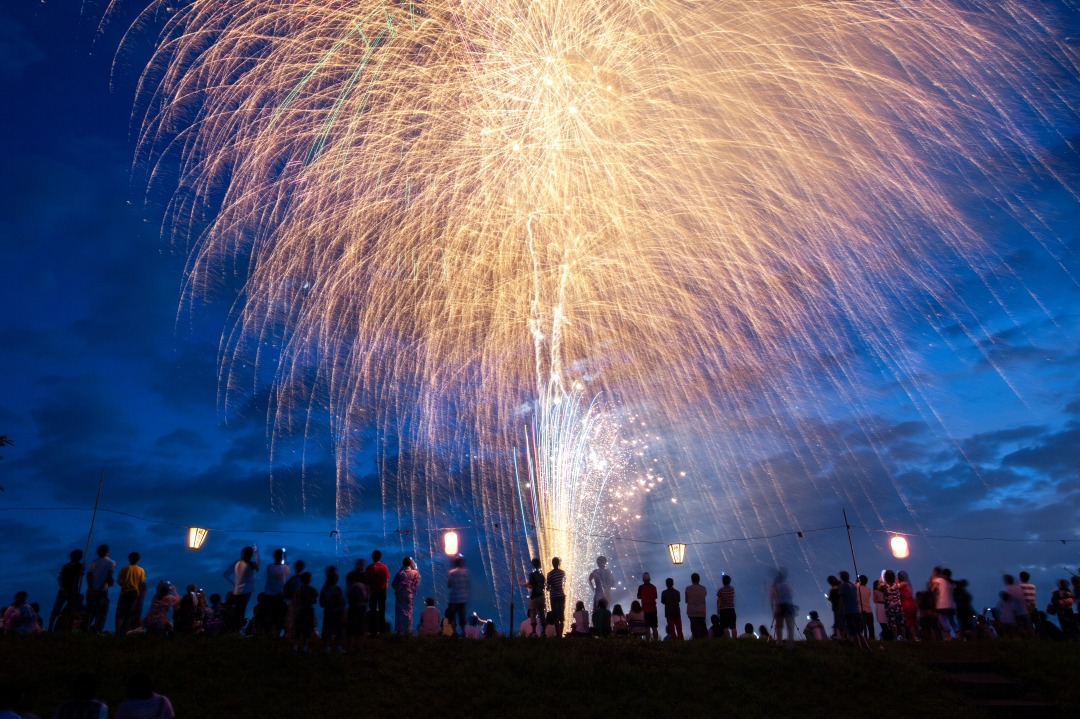
At the west exit, two major station buildings are said to be the landmarks of Kita-Senju, which are Lumine Kita-Senju and Kita-Senju Marui. Two buildings are always crowded with people who enjoy shopping and meals. Tokiwa Street, which stretches south, is lined with restaurants open since the Showa Period. There are also fashionable taverns for women, standing taverns, and popularized Kansai-style taverns. Therefore, many people visit Kita-Senju to have a drink. Moreover, there are historical shopping streets such as "Kitarodo 1010" and "Shukubamachi Street." Kita-Senju Station area is a place where people can enjoy the downtown atmosphere.
In addition, there are many public baths around Kita-Senju Station, which attract attention from locals and nationwide fans.
Although the Kita-Senju Station area is in the twenty-three wards, the cost of living and rent are lower than in the city center. It is an attractive city for those who are looking for a comfortable place to live. According to the data, the number of foreign residents is increasing yearly. Foreign residents in Adachi Ward, where Kita-Senju Station is located, are 39,331 as of January 2024. In the twenty-three wards, it has the second largest number of foreign residents after Edogawa Ward. According to a survey by Adachi Ward, it shows that many foreigners have a stable living base here and the homeownership rate even exceeds 40%.
Source: Tokyo Metropolitan Government's statistics "Table 1: Foreign Population by Nationality and Region by Municipality (Top 10 Countries/Regions)"
Source: Adachi Ward "Adachi Ward Foreigner Fact-finding Survey 2021 (Reiwa 3) October Implementation Report
The Kita-Senju Station area: transferring from a post town to a student town and a place filled with high-rise buildings
The area around Kita-Senju Station had developed as a transportation hub even before the station started operation—the history of Kita-Senju dates to the Edo period in 1624. The Nikko Highway from Edo (the predecessor of Tokyo) to Nikko was constructed, and in 1625 "Senju-juku" was built as a posthouse. As a result, the population increased as the traffic volume increased, and markets for rice, vegetables, and fish were formed. As commerce flourished, Senju-juku also developed as a cultural center.
Kita-Senju Station was established more than two hundred years later, in 1896. It opened as a station on the Japan Railway Tsuchiura Line (now the Joban Line). Three years later, the Tobu Isesaki Line opened, and Kita-Senju Station became a transfer station. Subsequently, construction was carried out and in 1962 the Hibiya Line opened and began direct operation with the Tobu Isesaki Line. With the opening of the Chiyoda Line in 1969, Kita-Senju Station became accessible to four lines, making it easier to access the city center from Kita-Senju.
After entering the Heisei Period, large-scale improvement work began in 1992 at a cost of about fifty-one billion yen. In 2003, it began direct operation with the Hanzomon Line, and the Tobu Isesaki Line was directly connected to the city center. In 2005, the Tsukuba Express Line started operation, and Kita-Senju Station became a terminal station connecting the suburbs and the city center, with five lines serving it.
Along with the changes in Kita-Senju Station, urban redevelopment around the station is also continuing. In 1987, an urban redevelopment project was decided at the west exit, and in 2004, the facility "Senju Mildix" opened. At the East Exit, Tokyo Denki University opened in 2012. There was no university in Adachi Ward until 1993 due to the application of a law restricting the establishment of new universities. After this law was repealed in 2002, in 2005, Adachi Ward presented a community development concept - "Adachi Ward Culture, Industry, and Arts New City Center," aiming to redevelop the city. Since then, Kita-Senju Station started to develop as a student town.
In addition, a redevelopment plan is underway at the East Exit of Kita-Senju Station, including a tower condominium with a height of about 120 meters, department stores, and child-rearing support facilities. The government is aiming to decide on urban planning within the next few years, and it is expected to revitalize the city.
Recommended places to visit near Kita-Senju Station
The area around Kita-Senju Station has undergone various changes and developments. It has become an area blending the atmosphere of downtown and advancement. Here are some spots where people can experience the cityscape around Kita-Senju Station.
A place for cuisine and shopping in Kita-Senju! -
Kita-Senju Marui, a large department store located at the west exit. It is a landmark of Kita-Senju. There are many men's, women's, and children's fashion shops, and there are also plenty of miscellaneous goods and cosmetics shops.
In 2020, Kita-Senju Marui ranked first in terms of sales floor area and sales among all twenty-three stores. Thanks to the residents of the vicinity of Kita-Senju Station and the passengers who transfer from Kita-Senju Station.
On the first basement floor and the first floor, there is a wide variety of take-out shops. There is not only fresh food but also a wide variety of side dishes such as sushi, Chinese food, and tempura. In the restaurant area on the ninth floor, people will find a fried pork chop specialty restaurant born in Kyoto and some downtown restaurants.
If you want to enjoy shopping and meals around Kita-Senju all at once, Kita-Senju Marui is a perfect place to visit.
Kita-Senju Marui Official Website
Enjoy eating traditional food and strolling -
Spreading out on the old Nikko Kaido and the posthouse in the direction of the west exit is the Senju Honcho shopping street. There are one hundred stores with a wide variety of products. It is also a place people can enjoy eating and walking. It is often introduced in specific features on TV programs.
Founded in 1948, the Japanese confectionery shop "Kadoya" specializes in Japanese dango, which is an old-fashioned baked dumpling. There are two flavors, soy sauce and red bean paste.
There are other shops that are worth visiting, and the shopping street is crowded with many people every day. The low price makes it a perfect spot to buy grocery.
Senju Honcho Shopping Street Official Website
A place of relaxation with an abundant natural atmosphere
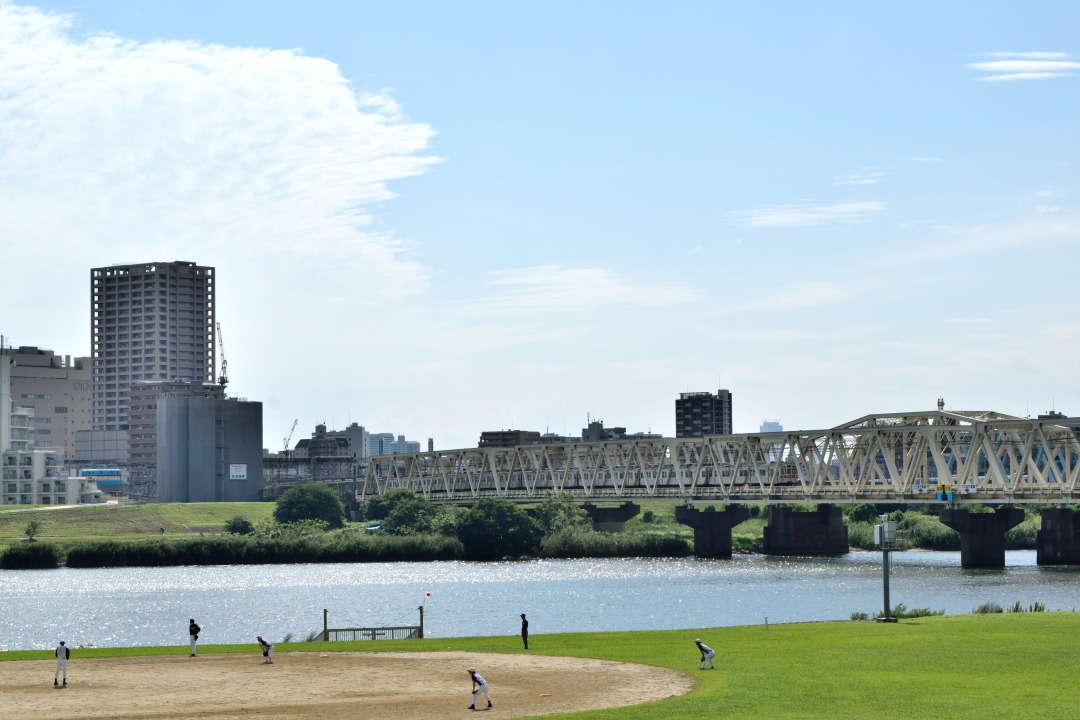
At the east side of Kita-Senju Station, the Arakawa riverbank spreads. There are many sport fields such as ballparks, playgrounds, and parks.
Among them, the park "Rainbow Square" is located on the north side of Kita-Senju Station. Eight flower beds have been maintained in Rainbow Square, and the ground between the flower beds is painted with bricks of "rainbow paintings". In spring, tulips of seven colors are planted in each flower bed, and if people look at the flower bed from the top of the bank, they can see the gorgeous appearance of the tulips in the flower bed connecting the rainbow paintings in the square. Since there is no playground equipment, it is a good spot for picnics, walking, and cycling.
In addition, the Arakawa riverbank is a popular spot where people can see the annual summer tradition "Adachi Fireworks".
Experience the history, the origin of Kita-Senju – “Senju-juku”
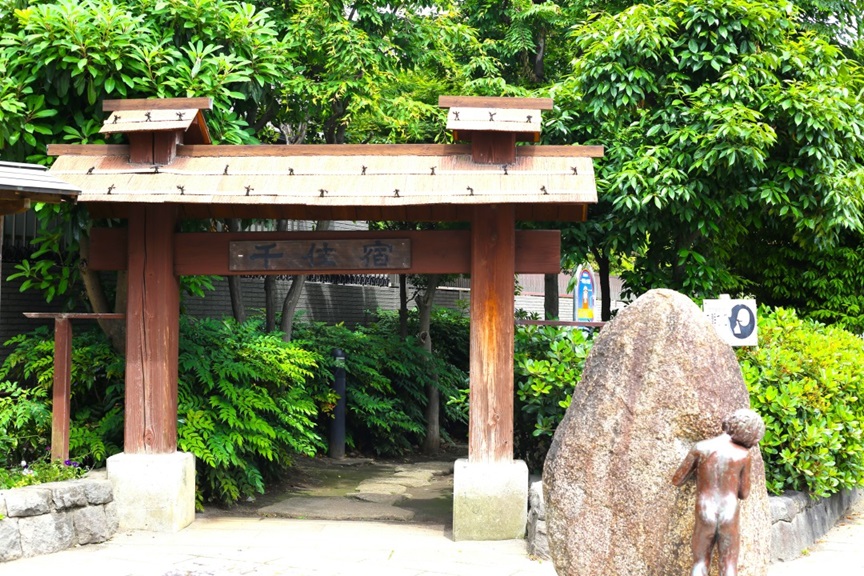
"Senju-juku", the origin of Kita-Senju, was born in 1625. In 2025, people will celebrate the 400th anniversary of the opening of the Senju-juku. The area around the place where Senju-juku used to be is now reborn as a shopping street (Shukubamachi Street).
Senju-juku was the first posthouse on the Nikko Kaido and was developed as an approach connecting Edo to Toshogu Shrine. With a population of 9,956 in 1844, it was the top of the four Edo inns (Naito Shinjuku, Shinagawa-juku, Itabashi-juku, and Senju-juku). It is said that the construction of the Senju Bridge over the Sumida River in 1594 was a major catalyst for the prosperity of the area around Senju-juku, because it connected the land and water route.
Currently, in Senju Honcho Park on the old Nikko Kaido, there is a guide map of Senju-juku historical sites. The map was created to convey the atmosphere of Senju-juku. It is a spot where you can trace the history of Senju-juku.
A historical public bath with a Japanese garden -
The area around Kita-Senju Station is dotted with several public baths. Among them, Takara Yu, located northwest of Kita-Senju Station, is a public bath that boasts a Japan garden on the men's bath side. Among lovers of public bath, Takara Yu is known as the "King of Balcony" or "King of Gardens".
In the garden, you can find seasonal flowers and trees such as azaleas, hydrangeas, and maple trees. People can see Nishiki swimming in the pond. Sitting on the veranda after the bath while looking at the garden is truly refreshing. There is also a full-fledged Finnish sauna in the women's bath, where people can relieve their stresses.
It is also a hotspot for shooting drama scenes. Undoubtedly, not only locals but also public bath lovers from all over the country gather in Takara Yu.
You can check photos of Takara Yu's baths and gardens on the official website.
Kita-Senju Station has more passengers than Akihabara Station and Ueno Station! Fun facts about Kita-Senju Station
Finally, we would like to introduce two trivia facts about Kita-Senju Station. If you meet someone who know these, you may call them the Master of Kita-Senju Station.
Does a train only run one station? Train runs from Kita-Senju Station to Minami-Senju Station.
On the Tokyo Metro Hibiya Line, there is a train that operates "only one station" between Kita-Senju Station and Minami-Senju Station. It takes about 3 minutes from the departure station to the terminal station, and the distance between stations is only 2.1 km.
There are three trains from Kita-Senju to Minami-Senju on weekdays and six trains from Minami-Senju to Kita-Senju on weekdays and one on weekends and holidays. Why is there a train that runs only at this one station?
Between Minami-Senju Station and Kita-Senju Station on the Hibiya Line, there is a train depot, the Senju Trian Inspection Station. However, since the in/out line of the Senju Inspection Area is only on the Minami-Senju Station side, the train that leaves the Inspection Area and departs from Kita-Senju has no choice but to head to Minami-Senju Station.
Therefore, this "one-station train" operates the train that moves from Minami-Senju Station to Kita-Senju Station was borne.
Kita-Senju Station is far from the city center, but why are there so many passengers?
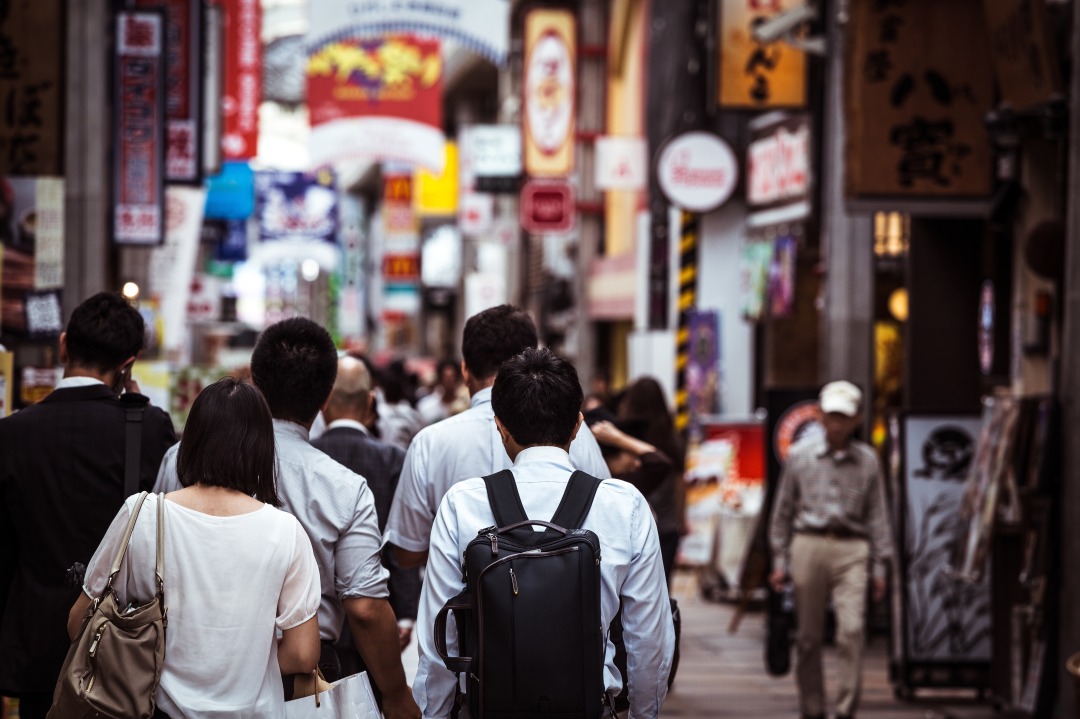
In the 2021 ranking of the number of passengers by station at JR Japan stops, Kita-Senju Station boasts the eighth place. This is more than Shimbashi (ninth), Akihabara (11th), and Ueno (14th). Even sometimes there were more passengers than Tokyo Station.
Kita-Senju is in Adachi Ward, a so-called "downtown area" that is a little outside the city center of Chiyoda Ward and Minato Ward. Why are there so many passengers pass through Kita-Senju Station?
Since Kita-Senju Station is a transfer point for people coming to Tokyo from Saitama, Tochigi, Gunma, and Ibaraki in the northern Kanto area, the number of its passengers increase. It is also a convenient station to use when heading to the city center from Chiba or Saitama.
In addition, there are five universities around Kita-Senju Station which also cause the increase of passengers. Thus, the Kita-Senju area has a high prospect of rental income, and investment real estate can expect stable income.
The area around Kita-Senju Station is cheaper, and the rent is slightly lower than the neighboring Akihabara, Asakusa, and Ueno. There are several shopping streets, and many historical shops. The retro boom in Reiwa period tends to attract more young people and people from overseas.
The Kita-Senju Station area, which has good access to the city center and is in the twenty-three wards, has low prices and rents compared to the city center, and is expected to increase in value in the future.
Summary
The Kita-Senju Station area has a downtown atmosphere combine with strong modern elements. Not only the residents, but also the number of young people and foreigners has increased, making it a lively city.
Although it is in the 23rd ward, the cost of living and rent are reasonable, and the aspect of transportation is remarkable. Moreover, there are many spots around the station where people can sense the history.
If you are considering purchasing real estate around Kita-Senju Station, please refer to the information provided in this article.


